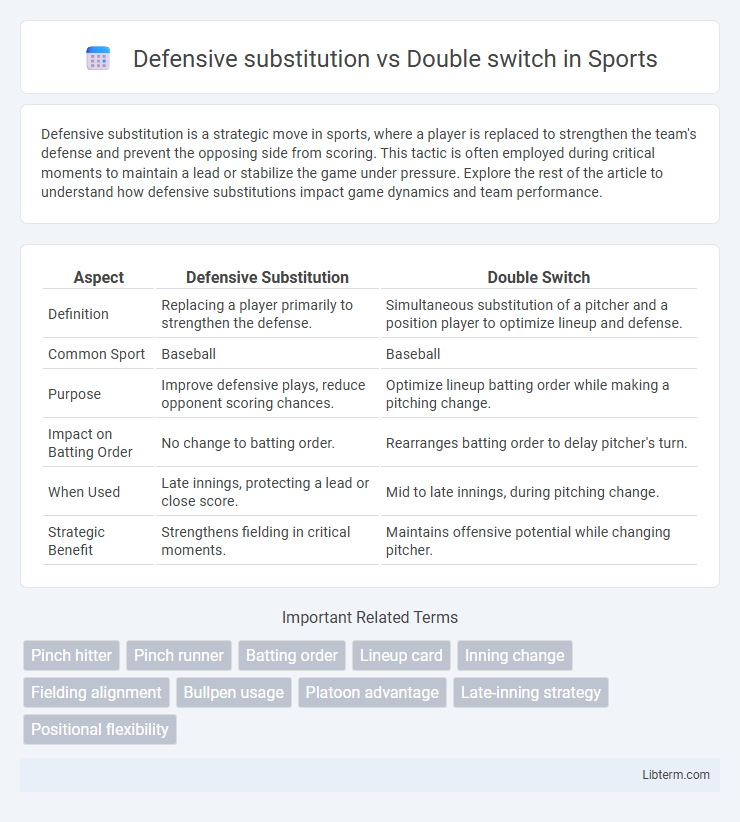Defensive substitution is a strategic move in sports, where a player is replaced to strengthen the team's defense and prevent the opposing side from scoring. This tactic is often employed during critical moments to maintain a lead or stabilize the game under pressure. Explore the rest of the article to understand how defensive substitutions impact game dynamics and team performance.
Table of Comparison
| Aspect | Defensive Substitution | Double Switch |
|---|---|---|
| Definition | Replacing a player primarily to strengthen the defense. | Simultaneous substitution of a pitcher and a position player to optimize lineup and defense. |
| Common Sport | Baseball | Baseball |
| Purpose | Improve defensive plays, reduce opponent scoring chances. | Optimize lineup batting order while making a pitching change. |
| Impact on Batting Order | No change to batting order. | Rearranges batting order to delay pitcher's turn. |
| When Used | Late innings, protecting a lead or close score. | Mid to late innings, during pitching change. |
| Strategic Benefit | Strengthens fielding in critical moments. | Maintains offensive potential while changing pitcher. |
Understanding Defensive Substitution
Defensive substitution involves replacing a player solely for defensive purposes, often to enhance fielding capabilities or situational defense late in the game, without altering the batting order. This strategy contrasts with the double switch, which simultaneously changes two players to optimize both defensive alignment and batting sequence, typically in National League play. Understanding defensive substitution is crucial for managing game dynamics and maintaining optimal defensive strength while preserving offensive flexibility.
What is a Double Switch in Baseball?
A double switch in baseball is a strategic move where a manager replaces two players simultaneously, typically a pitcher and a position player, to optimize both defensive alignment and batting order. This substitution allows the new pitcher to take over a spot in the batting lineup that won't come up soon, improving offensive efficiency without sacrificing defense. Unlike a defensive substitution, which only swaps fielders and doesn't affect the batting order, a double switch impacts both fielding positions and the lineup's batting sequence.
Key Differences Between Defensive Substitution and Double Switch
Defensive substitution involves replacing a defensive player with another, typically without changing the batting order, optimizing field positioning and matchup advantages. A double switch simultaneously changes a defensive player and a pitcher, rearranging the batting order to prevent the new pitcher from batting soon, enhancing strategic flexibility. The key difference lies in the impact on the lineup: defensive substitutions do not alter the batting order, whereas double switches modify the lineup to optimize both defensive strategy and offensive opportunities.
Tactical Advantages of Defensive Substitution
Defensive substitution offers tactical advantages by strengthening a team's defense without altering the batting order, maintaining offensive consistency while shoring up vulnerabilities in the field. It enables a manager to replace a weaker defender with a more skilled player during critical game moments, minimizing run prevention risks. Unlike a double switch, it preserves pitcher-batter matchups, optimizing defensive alignment without compromising offensive strategy.
Strategic Benefits of Double Switch
The double switch in baseball strategically maximizes roster flexibility by allowing a manager to replace both a pitcher and a position player simultaneously, optimizing defensive alignment without compromising offensive potential. This tactic delays the pitcher's spot in the batting order, enhancing scoring opportunities while maintaining stronger field defense. Its strategic benefit lies in preserving bullpen stamina and prolonging effective gameplay under challenging match conditions.
Scenarios Favoring Defensive Substitution
Defensive substitutions are favored in scenarios where a team seeks to bolster late-inning defense to protect a narrow lead, often replacing a weak defensive player with a stronger defender without altering the batting order. This strategy excels when preserving pitcher stamina while maintaining optimal fielding position is critical, especially in tight games or high-leverage situations. Defensive substitutions contrast with double switches, the latter being more useful for pitchers while simultaneously adjusting the batting lineup to optimize matchups.
When to Use a Double Switch for Maximum Impact
A double switch is most effective during late innings when a manager needs to optimize both offensive and defensive alignments without burning a pinch hitter prematurely. This strategic move replaces the pitcher and a position player simultaneously, allowing the new pitcher to take over a spot in the batting order less critical to the team's scoring chances. Utilizing a double switch maximizes tactical advantage by improving defensive stability and preserving bench depth for subsequent innings.
Impact on Team Lineup and Batting Order
Defensive substitution replaces a player primarily for enhanced fielding, maintaining the existing batting order and allowing the team to strengthen defense without altering offensive strategy. The double switch simultaneously changes two players, typically inserting a new pitcher and a position player, resulting in significant lineup adjustments that optimize both defense and batting order to maximize strategic advantage. By altering the batting order, the double switch can delay the pitcher's turn at bat, improving offensive opportunities while maintaining defensive effectiveness.
Common Managerial Mistakes with Substitutions
Defensive substitutions often lead to common managerial mistakes such as neglecting the impact on batting order, resulting in weakened offensive potential. Double switch errors typically involve miscalculations in timing, causing confusion and inefficiency in player positioning and game strategy. Both substitution types require careful planning to avoid disrupting team dynamics and diminishing overall performance.
Best Practices for In-Game Substitution Strategy
Effective in-game substitution strategy involves using defensive substitutions to enhance team defense by replacing less skilled defenders with specialized players, optimizing field positioning, and managing pitcher stamina. Employing the double switch allows managers to simultaneously adjust both pitching and batting orders, improving lineup flexibility without losing offensive momentum. Best practices include analyzing player matchups, game context, and remaining innings to maximize defensive stability while maintaining offensive productivity.
Defensive substitution Infographic

 libterm.com
libterm.com